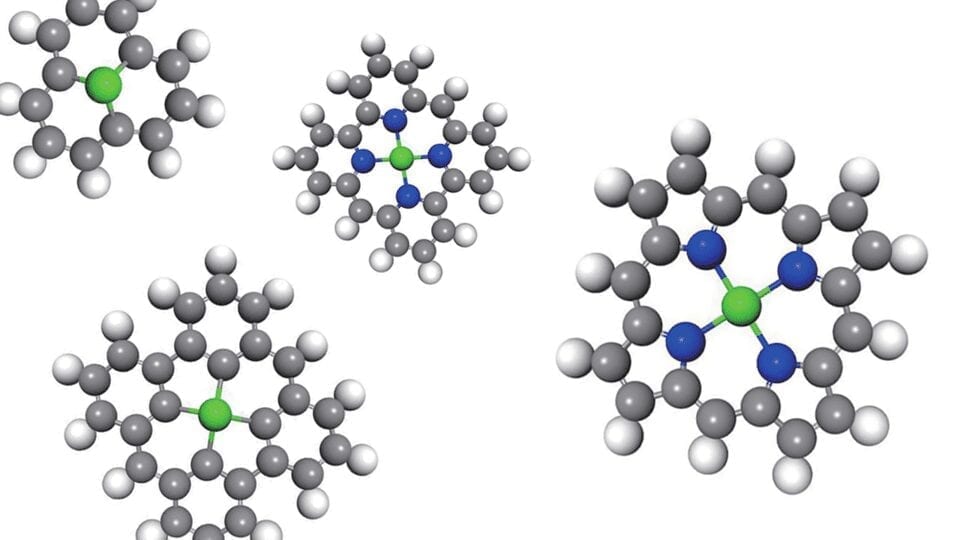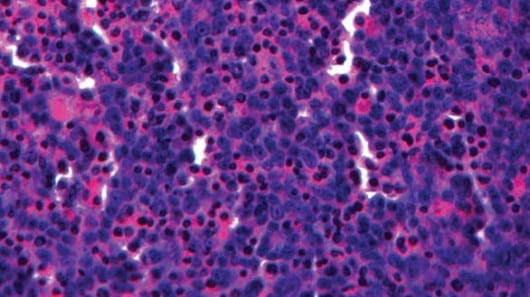
Promising results are a step toward a range of renewable energy strategies fueled by Nature
In a paper to be published in an upcoming issue of Energy & Environmental Science (now available online), researchers at the U.S. Department of Energy’s Brookhaven National Laboratory describe details of a low-cost, stable, effective catalyst that could replace costly platinum in the production of hydrogen. The catalyst, made from renewable soybeans and abundant molybdenum metal, produces hydrogen in an environmentally friendly, cost-effective manner, potentially increasing the use of this clean energy source.
The research has already garnered widespread recognition for Shilpa and Shweta Iyer, twin-sister high school students who contributed to the research as part of an internship under the guidance of Brookhaven chemist Wei-Fu Chen, supported by projects led by James Muckerman, Etsuko Fujita, and Kotaro Sasaki.
“This paper reports the ‘hard science’ from what started as the Iyer twins’ research project and has resulted in the best-performing, non-noble-metal-containing hydrogen evolution catalyst yet known—even better than bulk platinum metal,” Muckerman said.
The project branches off from the Brookhaven group’s research into using sunlight to develop alternative fuels. Their ultimate goal is to find ways to use solar energy—either directly or via electricity generated by solar cells—to convert the end products of hydrocarbon combustion, water and carbon dioxide, back into a carbon-based fuel. Dubbed “artificial photosynthesis,” this process mimics how plants convert those same ingredients to energy in the form of sugars. One key step is splitting water, or water electrolysis.
“By splitting liquid water (H2O) into hydrogen and oxygen, the hydrogen can be regenerated as a gas (H2) and used directly as fuel,” Sasaki explained. “We sought to fabricate a commercially viable catalyst from earth-abundant materials for application in water electrolysis, and the outcome is indeed superb.”
This form of hydrogen production could help the scientists achieve their ultimate goal.
“A very promising route to making a carbon-containing fuel is to hydrogenate carbon dioxide (or carbon monoxide) using solar-produced hydrogen,” said Fujita, who leads the artificial photosynthesis group in the Brookhaven Chemistry Department.
But with platinum as the main ingredient in the most effective water-splitting catalysts, the process is currently too costly to be economically viable.
Comsewogue High School students Shweta and Shilpa Iyer entered the lab as the search for a cost-effective replacement was on.
The Brookhaven team had already identified some promising leads with experiments demonstrating the potential effectiveness of low-cost molybdenum paired with carbon, as well as the use of nitrogen to confer some resistance to the corrosive, acidic environment required in proton exchange membrane water electrolysis cells. But these two approaches had not yet been tried together.
The students set out to identify plentiful and inexpensive sources of carbon and nitrogen, and test ways to combine them with a molybdenum salt.
“The students became excited about using familiar materials from their everyday lives to meet a real-world energy challenge,” Chen recounted. The team tested a wide variety of sources of biomass—leaves, stems, flowers, seeds, and legumes—with particular interest in those with high protein content because the amino acids that make up proteins are a rich source of nitrogen. High-protein soybeans turned out to be the best.
The Latest Bing News on:
Hydrogen Production
- Keeping Europe Competitive with Hydrogen: Insights from the Budapest Summiton April 27, 2024 at 3:00 pm
Jorgo Chatzimarkakis, the German-Greek CEO of Hydrogen Europe, suggested three objectives for the upcoming Hungarian presidency of the Council of the EU: a definition of green hydrogen; a definition ...
- World’s first hydrogen station for commercial trucks opens – is it too late?on April 27, 2024 at 7:58 am
FirstElement Fuels has opened the world's first large-scale hydrogen fueling station for heavy-duty commercial trucks at Port of Oakland.
- Mitsubishi Heavy Industries begins testing solid oxide electrolyzer cell for hydrogen productionon April 26, 2024 at 6:01 pm
The SOEC test module includes multiple cartridges of 500 cell stacks bundled together. MHI said results will be used to support higher output and capacity.
- Really Cold Hydrogen Could Bring Driving Range Parity with Dieselon April 26, 2024 at 3:33 pm
The time it takes to fuel a hydrogen-powered fuel cell truck is already on par with diesel. But there is still a yawning gap when it comes to comparable driving range.
- California Welcomes First Big-Rig Hydrogen Fuel Station in U.S.on April 26, 2024 at 9:08 am
The country’s first commercial hydrogen fuel station for big-rig trucks is up and running at the Port of Oakland, a step toward what hydrogen proponents see as a clean new future for long-haul ...
- Custom-made catalyst leads to longer-lasting and more sustainable green hydrogen productionon April 26, 2024 at 8:50 am
Researchers led by Ryuhei Nakamura at the RIKEN Center for Sustainable Resource Science (CSRS) in Japan have improved on their green and sustainable method of extracting hydrogen from water by using a ...
- Metal swarf transformed into electrodes for hydrogen productionon April 26, 2024 at 3:39 am
Nanotextured surface of titanium and nickel waste supports platinum and cobalt atoms to create effective electrocatalysts ...
- Nikola’s Hydrogen-Truck Fueling Strategyon April 25, 2024 at 5:00 pm
One of the criticisms of hydrogen as a transport fuel has been that the production of hydrogen itself can be a source of pollution and greenhouse gases. And that is something that Hyla is working to ...
- 3 Hydrogen Stocks to Buy on the Dip: April 2024on April 25, 2024 at 3:04 pm
InvestorPlace - Stock Market News, Stock Advice & Trading Tips Keep an eye on hydrogen stocks to buy on the dip. For one, according ...
- Green Hydrogen And Next-Gen Electrolyzers: Hystar’s CEO Calls For Norway’s Transitionon April 25, 2024 at 3:45 am
Hystar strives to become both a market and tech leader, producing both the energy source and the efficient electrolyzer technology to export worldwide.
The Latest Google Headlines on:
Hydrogen Production
[google_news title=”” keyword=”Hydrogen Production” num_posts=”10″ blurb_length=”0″ show_thumb=”left”] [/vc_column_text]The Latest Bing News on:
Solar-produced hydrogen
- Switzerland Inaugurates Its Largest Green Hydrogen Power Planton April 27, 2024 at 11:27 am
After a year's work, Switzerland's largest green hydrogen production facility was inaugurated on Friday, and it is poised to eliminate the need for ...
- World's cheapest hydrogen energy could be produced in Nepalon April 26, 2024 at 12:09 pm
Hydrogen expert and Professor at Kathmandu University, Biraj Singh Thapa, highlighted that Nepal should prepare for hydrogen energy, as its price is expected to decrease by 62% by 2030. He cited a UK ...
- SJVN unveils India's 1st multi-purpose green hydrogen projecton April 25, 2024 at 9:35 pm
The hydrogen production will be powered using solar power. SJVN has launched India’s first multi-purpose green hydrogen project which is a combined heat and power located in Jhakri, Himachal Pradesh.
- Green Hydrogen Development and Site Controlon April 25, 2024 at 5:00 pm
Here, we discuss what wind and solar producers should keep in mind as they plan, negotiate, and begin developing hydrogen plants powered by renewable energy, with a particular focus on site control.
- Green Hydrogen And Next-Gen Electrolyzers: Hystar’s CEO Calls For Norway’s Transitionon April 25, 2024 at 3:45 am
Hystar strives to become both a market and tech leader, producing both the energy source and the efficient electrolyzer technology to export worldwide.
- Superfood protein pulled out of thin air massively scales up productionon April 24, 2024 at 2:59 pm
The world's first commercial-scale factory for making nutrient-rich and versatile protein from air and sustainable energy has opened its doors in Finland, and the startup behind it aims to have its ...
- A second solar project takes off at JFK airporton April 24, 2024 at 9:27 am
TotalEnergies began construction of an onsite solar-plus-storage system, providing energy to Port Authority and Con Edison, as well as community solar for area residents.
- ‘Green hydrogen’ company looks to make Mississippi a leader of new renewable ventureon April 24, 2024 at 7:19 am
Hy Stor Energy will store its hydrogen in different salt domes around the state to feed a burgeoning renewable power source called "green hydrogen." ...
- Solar Energy Newson April 23, 2024 at 5:00 pm
Pairing Crypto Mining With Green Hydrogen Offers Clean Energy ... 2024 — Which process is best suited for mass production of perovskite solar cells? While solvent-based manufacturing processes ...
- Sinopec hydrogen venture up for grabson April 22, 2024 at 8:07 am
Sinopec New Star Inner Mongolia Green Hydrogen New Energy is being offered for auction on the Beijing Equity Exchange, with its entire equity up for grabs at a starting price of 74.08 million yuan ...
The Latest Google Headlines on:
Solar-produced hydrogen
[google_news title=”” keyword=”solar-produced hydrogen” num_posts=”10″ blurb_length=”0″ show_thumb=”left”]










